Pumping Station Desing - Second Edition by Robert L. Sanks, George Tchobahoglous, Garr M. Jones
Подождите немного. Документ загружается.

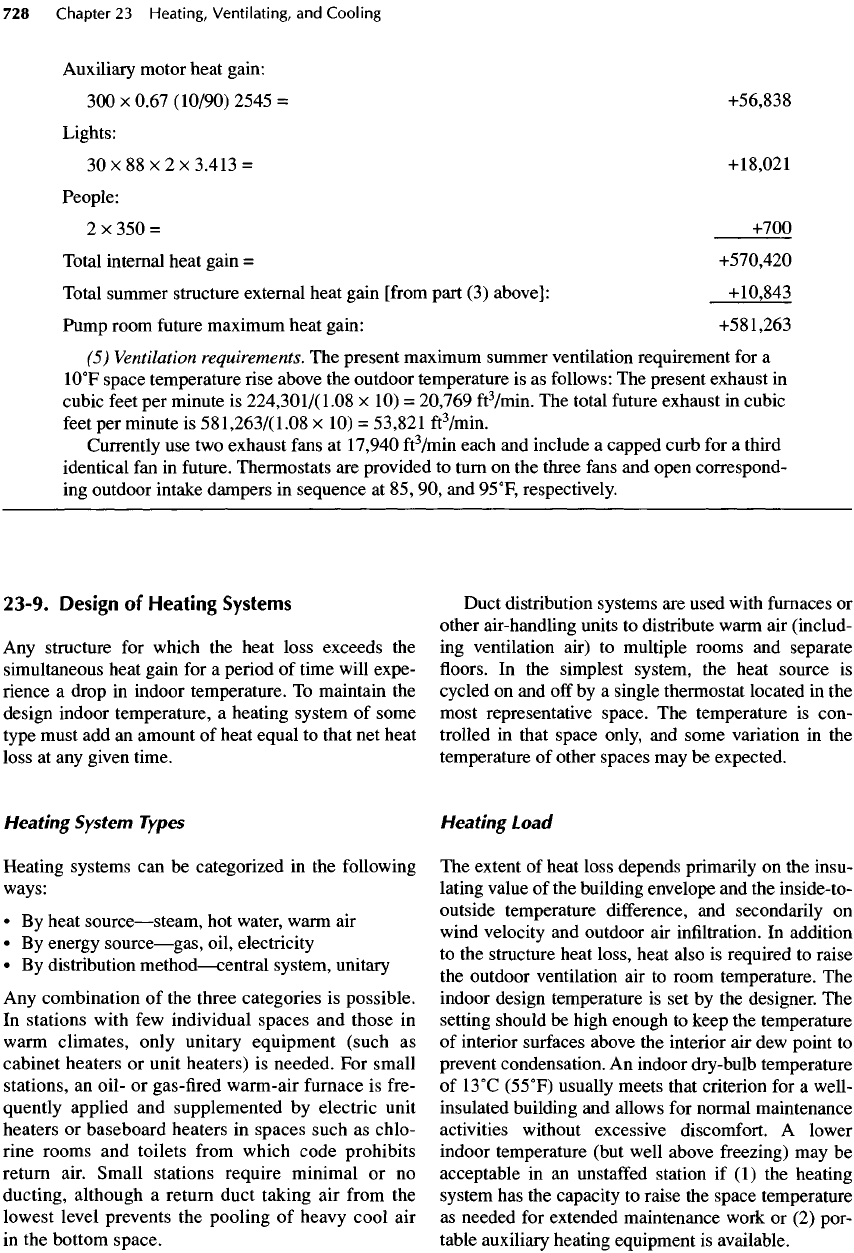
23-9.
Design
of
Heating
Systems
Any
structure
for
which
the
heat loss exceeds
the
simultaneous heat gain
for a
period
of
time will expe-
rience
a
drop
in
indoor temperature.
To
maintain
the
design indoor temperature,
a
heating system
of
some
type
must
add an
amount
of
heat equal
to
that
net
heat
loss
at any
given time.
Heating
System
Types
Heating systems
can be
categorized
in the
following
ways:
• By
heat
source
—
steam,
hot
water, warm
air
• By
energy
source
—
gas,
oil, electricity
• By
distribution
method
—
central
system, unitary
Any
combination
of the
three categories
is
possible.
In
stations
with
few
individual spaces
and
those
in
warm
climates, only unitary equipment (such
as
cabinet heaters
or
unit heaters)
is
needed.
For
small
stations,
an
oil-
or
gas-fired
warm-air
furnace
is
fre-
quently
applied
and
supplemented
by
electric
unit
heaters
or
baseboard heaters
in
spaces such
as
chlo-
rine
rooms
and
toilets
from
which code prohibits
return air. Small stations require minimal
or no
ducting,
although
a
return duct taking
air
from
the
lowest level prevents
the
pooling
of
heavy cool
air
in
the
bottom space.
Duct distribution systems
are
used with
furnaces
or
other air-handling units
to
distribute warm
air
(includ-
ing
ventilation air)
to
multiple rooms
and
separate
floors.
In the
simplest system,
the
heat source
is
cycled
on and
off
by a
single thermostat
located
in the
most representative space.
The
temperature
is
con-
trolled
in
that space only,
and
some variation
in the
temperature
of
other spaces
may be
expected,
Heating
Load
The
extent
of
heat
loss
depends
primarily
on the
insu-
lating value
of the
building envelope
and the
inside-to-
outside temperature
difference,
and
secondarily
on
wind velocity
and
outdoor
air
infiltration.
In
addition
to
the
structure heat loss, heat also
is
required
to
raise
the
outdoor ventilation
air to
room temperature.
The
indoor design temperature
is set by the
designer.
The
setting should
be
high enough
to
keep
the
temperature
of
interior
surfaces
above
the
interior
air dew
point
to
prevent condensation.
An
indoor dry-bulb temperature
of
13
0
C
(55
0
F)
usually meets that criterion
for a
well-
insulated building
and
allows
for
normal maintenance
activities without excessive discomfort.
A
lower
indoor temperature (but well above freezing)
may be
acceptable
in an
unstaffed
station
if (1) the
heating
system
has the
capacity
to
raise
the
space temperature
as
needed
for
extended maintenance work
or (2)
por-
table auxiliary heating equipment
is
available.
Auxiliary motor heat gain:
300 x
0.67
(10/90)
2545
=
+56,838
Lights:
30
x 88 x 2 x
3.413
=
+18,021
People:
2
x 350 =
+700
Total
internal heat gain
=
+570,420
Total
summer structure external heat gain
[from
part
(3)
above]:
+10,843
Pump room
future
maximum heat
gain:
+581,263
(5)
Ventilation
requirements.
The
present maximum summer ventilation requirement
for a
1O
0
F
space temperature
rise
above
the
outdoor temperature
is as
follows:
The
present exhaust
in
cubic
feet
per
minute
is
224,3017(1.08
x 10) =
20,769
ft
3
/min.
The
total
future
exhaust
in
cubic
feet
per
minute
is
581,2637(1.08
x 10) =
53,821
ft
3
/min.
Currently
use two
exhaust
fans
at
17,940
ft
3
/min
each
and
include
a
capped curb
for a
third
identical
fan in
future.
Thermostats
are
provided
to
turn
on the
three
fans
and
open correspond-
ing
outdoor intake dampers
in
sequence
at 85, 90, and
95
0
F,
respectively.
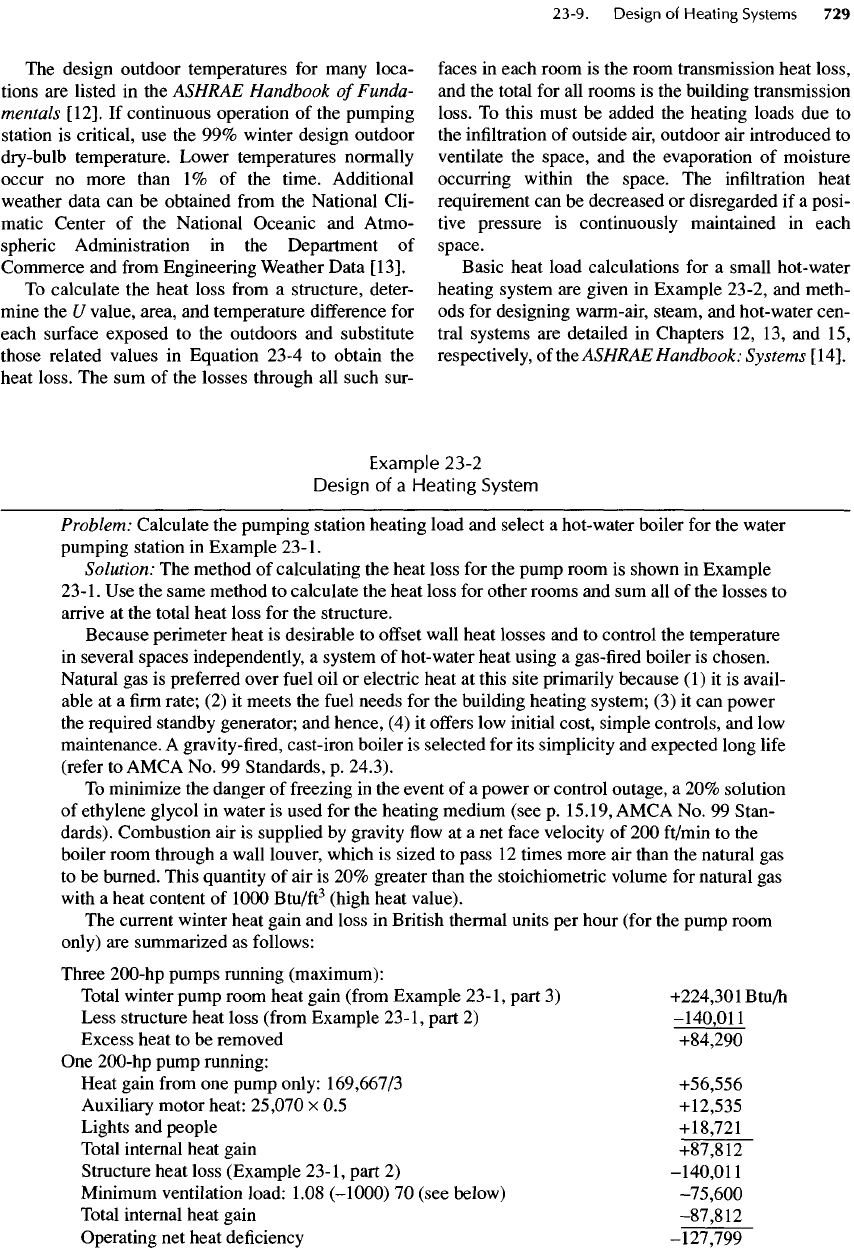
The
design outdoor temperatures
for
many loca-
tions
are
listed
in the
ASHRAE
Handbook
of
Funda-
mentals
[12].
If
continuous operation
of the
pumping
station
is
critical,
use the 99%
winter design outdoor
dry-bulb
temperature. Lower temperatures normally
occur
no
more than
1%
of the
time. Additional
weather data
can be
obtained
from
the
National
Cli-
matic Center
of the
National Oceanic
and
Atmo-
spheric Administration
in the
Department
of
Commerce
and
from
Engineering Weather Data
[13].
To
calculate
the
heat loss
from
a
structure, deter-
mine
the U
value, area,
and
temperature
difference
for
each
surface
exposed
to the
outdoors
and
substitute
those related values
in
Equation
23-4
to
obtain
the
heat loss.
The sum of the
losses through
all
such
sur-
faces
in
each room
is the
room transmission heat loss,
and
the
total
for all
rooms
is the
building transmission
loss.
To
this must
be
added
the
heating loads
due to
the
infiltration
of
outside
air,
outdoor
air
introduced
to
ventilate
the
space,
and the
evaporation
of
moisture
occurring within
the
space.
The
infiltration
heat
requirement
can be
decreased
or
disregarded
if a
posi-
tive pressure
is
continuously maintained
in
each
space.
Basic heat load calculations
for a
small
hot-
water
heating system
are
given
in
Example
23-2,
and
meth-
ods for
designing warm-air, steam,
and
hot-
water
cen-
tral systems
are
detailed
in
Chapters
12,
13,
and 15,
respectively,
of
the
ASHRAE
Handbook:
Systems
[14].
Example
23-2
Design
of a
Heating
System
Problem: Calculate
the
pumping station heating load
and
select
a
hot-water
boiler
for the
water
pumping
station
in
Example
23-1.
Solution:
The
method
of
calculating
the
heat loss
for the
pump room
is
shown
in
Example
23-1.
Use the
same method
to
calculate
the
heat loss
for
other rooms
and sum all of the
losses
to
arrive
at the
total heat loss
for the
structure.
Because perimeter heat
is
desirable
to
offset
wall heat losses
and to
control
the
temperature
in
several spaces independently,
a
system
of
hot-water
heat using
a
gas-fired
boiler
is
chosen.
Natural
gas is
preferred over
fuel
oil or
electric heat
at
this site primarily because
(1) it is
avail-
able
at a firm
rate;
(2) it
meets
the
fuel
needs
for the
building heating system;
(3) it can
power
the
required standby generator;
and
hence,
(4) it
offers
low
initial cost, simple controls,
and low
maintenance.
A
gravity-fired,
cast-iron boiler
is
selected
for its
simplicity
and
expected long
life
(refer
to
AMCA
No. 99
Standards,
p.
24.3).
To
minimize
the
danger
of
freezing
in the
event
of a
power
or
control outage,
a 20%
solution
of
ethylene glycol
in
water
is
used
for the
heating medium
(see
p.
15.19,
AMCA
No. 99
Stan-
dards). Combustion
air is
supplied
by
gravity
flow at a net
face
velocity
of 200
ft/min
to the
boiler room through
a
wall louver, which
is
sized
to
pass
12
times more
air
than
the
natural
gas
to
be
burned. This
quantity
of air is 20%
greater than
the
stoichiometric volume
for
natural
gas
with
a
heat content
of
1000
Btu/ft
3
(high heat value).
The
current winter heat gain
and
loss
in
British thermal units
per
hour (for
the
pump room
only)
are
summarized
as
follows:
Three
200-hp pumps running (maximum):
Total
winter pump room heat gain
(from
Example
23-1,
part
3)
+224,301
Btu/h
Less structure heat loss
(from
Example
23-1,
part
2)
-140,011
Excess heat
to be
removed +84,290
One
200-hp pump running:
Heat gain
from
one
pump only:
169,667/3
+56,556
Auxiliary
motor heat:
25,070
x 0.5
+12,535
Lights
and
people +18,721
Total internal heat gain +87,812
Structure
heat loss (Example
23-1,
part
2)
-140,011
Minimum
ventilation
load:
1.08 (-1000)
70
(see
below)
-75,600
Total internal heat gain
-87,812
Operating
net
heat
deficiency
-127,799

With
all
pumps off,
the
station
not
operating,
no
ventilation,
no
lights,
and no
people,
the
building
heat loss
is
140,011
Btu/h.
The
minimum outside
air
rate
for
ventilating this city water pumping station
was
selected
as
1000
ft
3
/min,
or
roughly double
the
calculated infiltration.
The
ventilation
air
heating load
in
British thermal units
per
hour
is
H
= W x c x
AT
(23-6)
where
W is the
weight
of air in
pounds
per
hour
(60 y
ft
3
/min
=
1.08
Ib/h),
c is the
specific heat
in
British thermal units
per
pound-degree
(0.2395
from
Table A-3),
and
AT
is the
difference
between
outside
and
inside temperatures
in
degrees Fahrenheit. Note that
W can be
expressed
as
Q
x 60 x y,
where
Q is the flowrate in
cubic
feet
per
minute
and y is the
specific
weight
of air in
pounds
per
cubic
feet
(0.0752
at sea
level
from
Table A-7). Collecting
and
multiplying
the
con-
stants
gives
H
=
1.08QxAr
(23-7)
The
outside
air
(ventilation) heat load
in
British thermal units
per
hour
is
H
OA
=
1.08(-1000)[60-(-10)]
=
-75,600
Heat equal
to the
greatest operating
net
heat deficiency
(127,799
Btu/h
from
the
previous cal-
culations
when only
one
pump
is
running) must
be
added
to the
pump room
to
maintain
the
design temperature. Heating equipment capacity should
be
adequate
to
maintain room tempera-
ture
at
45
0
F
or
higher under
any
condition.
Boiler
input
=
(
HD
+
"<*»-
2
(23
.
8)
O.O
where
HD is the net
heat deficiency
in
British thermal units
per
hour,
1.2 is a
"piping
and
pickup" allowance
for
generated heat
not
conveyed
to the
heated space
and for
extra capacity
for
quicker
warmup
from
a
reduced setback temperature,
and 0.8 is the
boiler thermal
efficiency.
Note that
flue gas
heat loss (including heating
of the
combustion air)
is
included
in the
thermal
efficiency
factor. Calculations
(in
Btu/h)
for the
boiler size are:
•
Operating pump room
net
heat deficiency
(1
pump)
-127,799
•
Calculated remainder
of
building heat loss (not shown)
-77,201
•
Minimum ventilation heat load
-75,600
•
Total building heating load
-280,600
•
Boiler input
280,600(
1.2)/0.8
420,900
Use the
next larger standard
boiler
with
an
input
of
450,000
Btu/h.
Required combustion
air (12
times
the gas to be
burned)
is
(450,000
Btu/h)(
12)
=
9Q
ft
3
/m
.
n
(lOOOBtu/ft
)(60min/h)
The
louver
face
area
is
(90
ft
3
/min)/(200
x
0.25
free
area)
= 1.8
ft
2
Specify
an
automatic vent damper
in the
boiler
flue to
minimize convection losses
from
the hot
boiler when
the
burner
is not firing
(see
p.
16.5
of the
ASHRAE
Handbook: Equipment
[15]).
Extend
a
Type
B
double-wall
or
insulated
full-size
steel
flue
through
the
roof
to a
height
that
is at
least
2 ft
above
a
parapet
(or
other obstruction within
10 ft
horizontally). Provide
a
ventilated sleeve
and
weatherproof
flashing at the
roof
and an
approved weatherproof
flue cap
at
the
top.
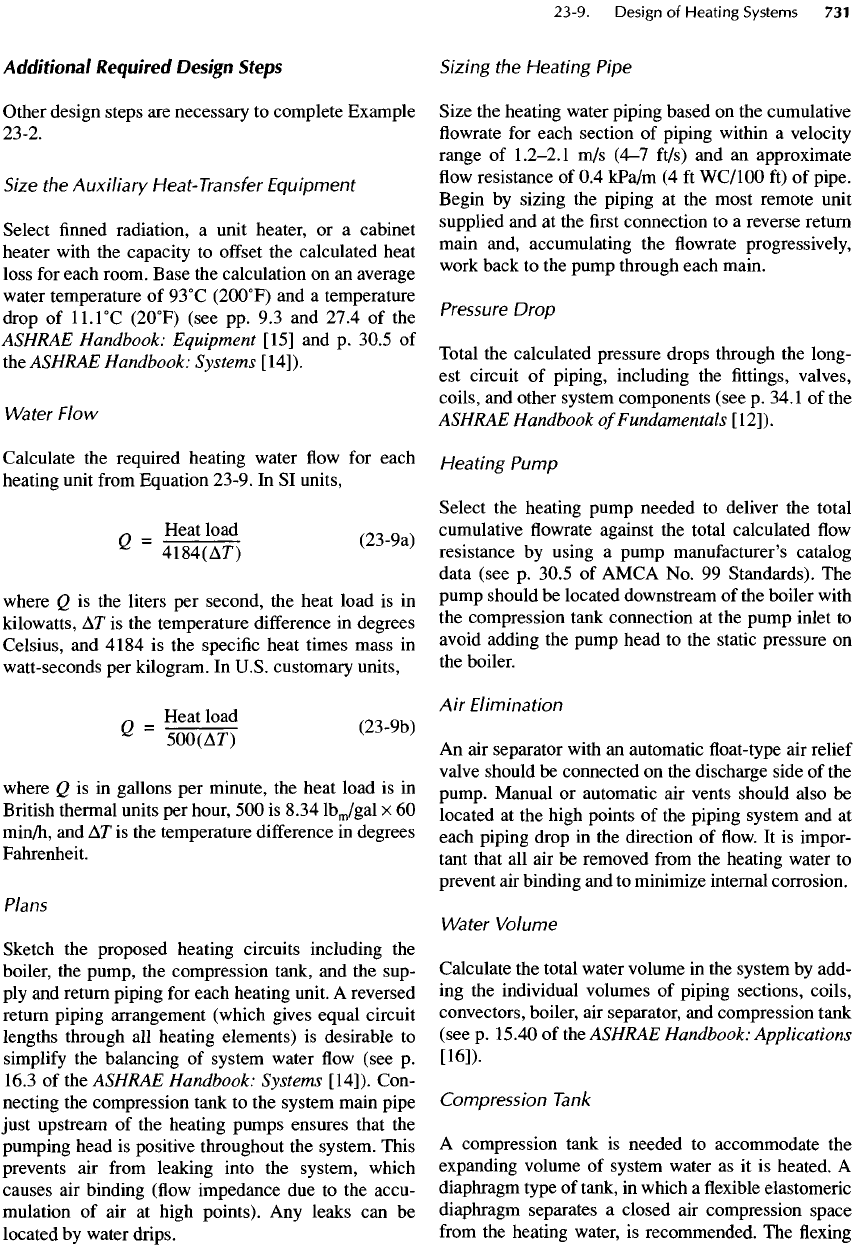
Additional
Required
Design
Steps
Other design steps
are
necessary
to
complete Example
23-2.
Size
the
Auxiliary
Heat-Transfer
Equipment
Select
finned
radiation,
a
unit heater,
or a
cabinet
heater
with
the
capacity
to
offset
the
calculated heat
loss
for
each room. Base
the
calculation
on an
average
water
temperature
of
93
0
C
(20O
0
F)
and a
temperature
drop
of
11.1
0
C
(2O
0
F)
(see
pp. 9.3 and
27.4
of the
ASHRAE
Handbook: Equipment
[15]
and p.
30.5
of
the
ASHRAE
Handbook:
Systems
[14]).
Water
Flow
Calculate
the
required heating water
flow for
each
heating
unit
from
Equation 23-9.
In SI
units,
n
_
Heat load
p
-
q
,
Q
4184(AD
(23
"
9a)
where
Q is the
liters
per
second,
the
heat load
is in
kilowatts,
AT
is the
temperature
difference
in
degrees
Celsius,
and
4184
is the
specific
heat times mass
in
watt-seconds
per
kilogram.
In
U.S. customary units,
Heat load
^
500(Ar)
V
;
where
Q is in
gallons
per
minute,
the
heat load
is in
British thermal units
per
hour,
500 is
8.34
lb
m
/gal
x 60
min/h,
and AT is the
temperature
difference
in
degrees
Fahrenheit.
Plans
Sketch
the
proposed heating circuits including
the
boiler,
the
pump,
the
compression tank,
and the
sup-
ply
and
return piping
for
each heating unit.
A
reversed
return
piping arrangement (which gives equal circuit
lengths through
all
heating elements)
is
desirable
to
simplify
the
balancing
of
system water
flow
(see
p.
16.3
of the
ASHRAE
Handbook:
Systems
[14]).
Con-
necting
the
compression tank
to the
system main pipe
just
upstream
of the
heating pumps ensures that
the
pumping
head
is
positive throughout
the
system. This
prevents
air
from
leaking into
the
system, which
causes
air
binding
(flow
impedance
due to the
accu-
mulation
of air at
high points).
Any
leaks
can be
located
by
water drips.
Sizing
the
Heating
Pipe
Size
the
heating water piping based
on the
cumulative
flowrate
for
each section
of
piping within
a
velocity
range
of
1.2-2.1
m/s
(4-7
ft/s)
and an
approximate
flow
resistance
of 0.4
kPa/m
(4 ft
WC/100
ft) of
pipe.
Begin
by
sizing
the
piping
at the
most remote unit
supplied
and at the first
connection
to a
reverse return
main and, accumulating
the flowrate
progressively,
work
back
to the
pump through each main.
Pressure
Drop
Total
the
calculated pressure drops through
the
long-
est
circuit
of
piping, including
the fittings,
valves,
coils,
and
other system components (see
p.
34.1
of the
ASHRAE
Handbook
of
Fundamentals
[12]).
Heating Pump
Select
the
heating pump needed
to
deliver
the
total
cumulative
flowrate
against
the
total calculated
flow
resistance
by
using
a
pump manufacturer's catalog
data (see
p.
30.5
of
AMCA
No. 99
Standards).
The
pump
should
be
located downstream
of the
boiler
with
the
compression tank connection
at the
pump inlet
to
avoid
adding
the
pump head
to the
static pressure
on
the
boiler.
Air
Elimination
An
air
separator with
an
automatic
float-type air
relief
valve
should
be
connected
on the
discharge side
of the
pump.
Manual
or
automatic
air
vents should also
be
located
at the
high points
of the
piping system
and at
each piping drop
in the
direction
of flow. It is
impor-
tant that
all air be
removed
from
the
heating water
to
prevent
air
binding
and to
minimize internal corrosion.
Water
Volume
Calculate
the
total water volume
in the
system
by
add-
ing
the
individual volumes
of
piping sections, coils,
convectors, boiler,
air
separator,
and
compression tank
(see
p.
15.40
of the
ASHRAE
Handbook: Applications
[16]).
Compression
Tank
A
compression tank
is
needed
to
accommodate
the
expanding volume
of
system water
as it is
heated.
A
diaphragm type
of
tank,
in
which
a flexible
elastomeric
diaphragm separates
a
closed
air
compression space
from
the
heating water,
is
recommended.
The flexing
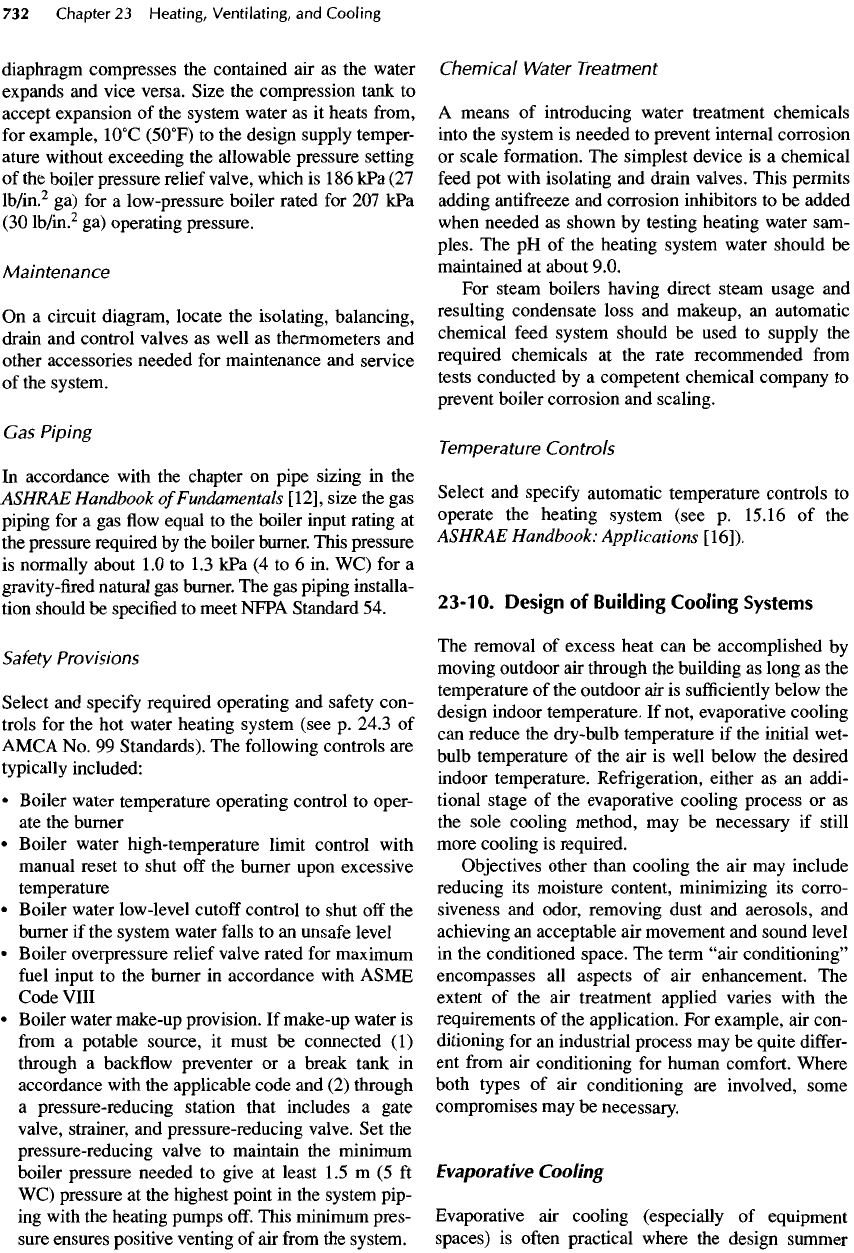
diaphragm compresses
the
contained
air as the
water
expands
and
vice versa. Size
the
compression tank
to
accept expansion
of the
system water
as it
heats
from,
for
example,
1O
0
C
(5O
0
F)
to the
design supply temper-
ature
without exceeding
the
allowable pressure setting
of
the
boiler pressure relief valve, which
is
186
kPa
(27
lb/in.
2
ga) for a
low-pressure
boiler
rated
for 207 kPa
(30
lb/in.
2
ga)
operating pressure.
Maintenance
On
a
circuit diagram,
locate
the
isolating, balancing,
drain
and
control valves
as
well
as
thermometers
and
other accessories needed
for
maintenance
and
service
of
the
system.
Gas
Piping
In
accordance with
the
chapter
on
pipe sizing
in the
ASHRAE
Handbook
of
Fundamentals
[12],
size
the gas
piping
for a gas flow
equal
to the
boiler input rating
at
the
pressure required
by the
boiler
burner. This pressure
is
normally about
1.0 to 1.3 kPa (4 to 6 in. WC) for a
gravity-fired
natural
gas
burner.
The gas
piping installa-
tion
should
be
specified
to
meet NFPA Standard
54.
Safety
Provisions
Select
and
specify
required operating
and
safety
con-
trols
for the hot
water heating system (see
p.
24.3
of
AMCA
No. 99
Standards).
The
following controls
are
typically included:
•
Boiler water temperature operating control
to
oper-
ate
the
burner
•
Boiler water high-temperature limit control with
manual
reset
to
shut
off the
burner upon excessive
temperature
•
Boiler water
low
-level
cutoff
control
to
shut
off the
burner
if the
system water
falls
to an
unsafe
level
•
Boiler overpressure relief valve rated
for
maximum
fuel
input
to the
burner
in
accordance with ASME
Code VIII
•
Boiler water make-up provision.
If
make-up water
is
from
a
potable source,
it
must
be
connected
(1)
through
a
backflow
preventer
or a
break tank
in
accordance
with
the
applicable code
and (2)
through
a
pressure-reducing station that includes
a
gate
valve,
strainer,
and
pressure-reducing valve.
Set the
pressure-reducing valve
to
maintain
the
minimum
boiler pressure needed
to
give
at
least
1.5
m
(5 ft
WC)
pressure
at the
highest point
in the
system pip-
ing
with
the
heating pumps off. This minimum pres-
sure
ensures positive venting
of air
from
the
system.
Chemical
Water Treatment
A
means
of
introducing water treatment chemicals
into
the
system
is
needed
to
prevent internal corrosion
or
scale formation.
The
simplest device
is a
chemical
feed
pot
with isolating
and
drain valves. This permits
adding antifreeze
and
corrosion inhibitors
to be
added
when needed
as
shown
by
testing heating water sam-
ples.
The pH of the
heating system water should
be
maintained
at
about 9.0.
For
steam
boilers
having direct steam usage
and
resulting condensate
loss
and
makeup,
an
automatic
chemical
feed
system should
be
used
to
supply
the
required chemicals
at the
rate recommended
from
tests conducted
by a
competent chemical company
to
prevent
boiler corrosion
and
scaling.
Temperature
Controls
Select
and
specify
automatic temperature controls
to
operate
the
heating system (see
p.
15.16
of the
ASHRAE
Handbook: Applications
[16]).
23-10.
Design
of
Building
Cooling Systems
The
removal
of
excess heat
can be
accomplished
by
moving outdoor
air
through
the
building
as
long
as the
temperature
of the
outdoor
air is
sufficiently
below
the
design indoor temperature.
If
not, evaporative cooling
can
reduce
the
dry-bulb temperature
if the
initial wet-
bulb temperature
of the air is
well below
the
desired
indoor temperature. Refrigeration, either
as an
addi-
tional stage
of the
evaporative cooling process
or as
the
sole cooling method,
may be
necessary
if
still
more cooling
is
required.
Objectives other than cooling
the air may
include
reducing
its
moisture content, minimizing
its
corro-
siveness
and
odor, removing dust
and
aerosols,
and
achieving
an
acceptable
air
movement
and
sound level
in
the
conditioned
space.
The
term "air
conditioning"
encompasses
all
aspects
of air
enhancement.
The
extent
of the air
treatment applied varies with
the
requirements
of the
application.
For
example,
air
con-
ditioning
for an
industrial process
may be
quite
differ-
ent
from
air
conditioning
for
human comfort. Where
both types
of air
conditioning
are
involved, some
compromises
may be
necessary.
Evaporative
Cooling
Evaporative
air
cooling (especially
of
equipment
spaces)
is
often
practical where
the
design summer
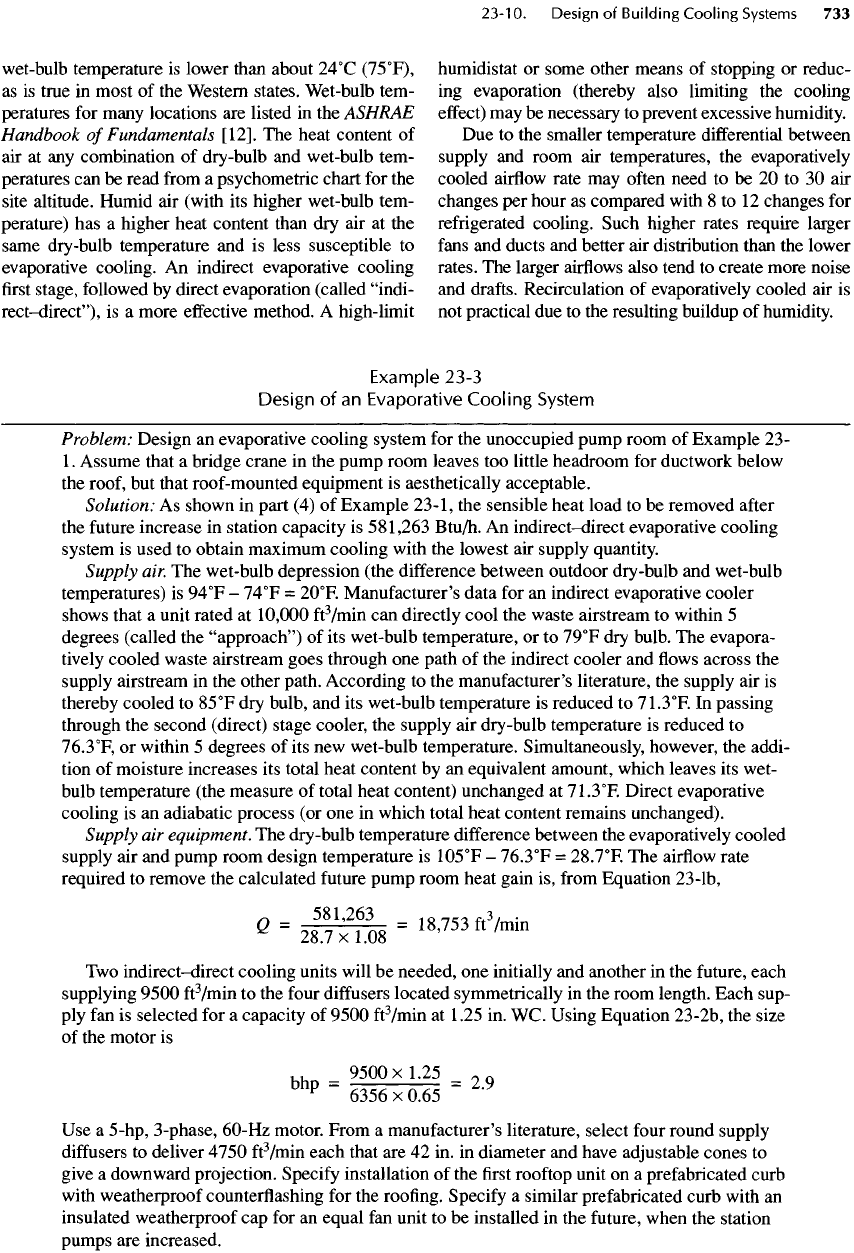
wet-bulb
temperature
is
lower than about
24
0
C
(75
0
F),
as
is
true
in
most
of the
Western states. Wet-bulb tem-
peratures
for
many locations
are
listed
in the
ASHRAE
Handbook
of
Fundamentals
[12].
The
heat content
of
air at any
combination
of
dry-bulb
and
wet-bulb tem-
peratures
can be
read
from
a
psychometric chart
for the
site altitude. Humid
air
(with
its
higher wet-bulb tem-
perature)
has a
higher heat content than
dry air at the
same dry-bulb temperature
and is
less susceptible
to
evaporative
cooling.
An
indirect evaporative cooling
first
stage,
followed
by
direct evaporation (called
"indi-
rect-direct"),
is a
more
effective
method.
A
high-limit
humidistat
or
some other means
of
stopping
or
reduc-
ing
evaporation (thereby also limiting
the
cooling
effect)
may be
necessary
to
prevent excessive humidity.
Due to the
smaller temperature
differential
between
supply
and
room
air
temperatures,
the
evaporatively
cooled
airflow
rate
may
often
need
to be 20 to 30 air
changes
per
hour
as
compared with
8 to 12
changes
for
refrigerated
cooling. Such higher rates
require
larger
fans
and
ducts
and
better
air
distribution than
the
lower
rates.
The
larger
airflows
also tend
to
create more noise
and
drafts.
Recirculation
of
evaporatively cooled
air is
not
practical
due to the
resulting buildup
of
humidity.
Example
23-3
Design
of an
Evaporative
Cooling
System
Problem: Design
an
evaporative cooling system
for the
unoccupied pump room
of
Example
23-
1.
Assume that
a
bridge crane
in the
pump room leaves
too
little headroom
for
ductwork below
the
roof,
but
that roof-mounted equipment
is
aesthetically acceptable.
Solution:
As
shown
in
part
(4) of
Example 23-1,
the
sensible heat load
to be
removed
after
the
future
increase
in
station capacity
is
581,263
Btu/h.
An
indirect-direct
evaporative cooling
system
is
used
to
obtain maximum cooling with
the
lowest
air
supply quantity.
Supply
air.
The
wet-bulb depression (the
difference
between outdoor dry-bulb
and
wet-bulb
temperatures)
is
94
0
F
-
74
0
F
=
2O
0
F.
Manufacturer's data
for an
indirect evaporative cooler
shows
that
a
unit rated
at
10,000
ft
3
/min
can
directly cool
the
waste airstream
to
within
5
degrees
(called
the
"approach")
of its
wet-bulb temperature,
or to
79
0
F
dry
bulb.
The
evapora-
tively
cooled waste airstream goes through
one
path
of the
indirect
cooler
and flows
across
the
supply
airstream
in the
other path. According
to the
manufacturer's literature,
the
supply
air is
thereby cooled
to
85
0
F
dry
bulb,
and its
wet-bulb temperature
is
reduced
to
71.3
0
F.
In
passing
through
the
second (direct) stage cooler,
the
supply
air
dry-bulb temperature
is
reduced
to
76.3
0
F,
or
within
5
degrees
of its new
wet-bulb temperature. Simultaneously, however,
the
addi-
tion
of
moisture increases
its
total heat content
by an
equivalent amount, which leaves
its
wet-
bulb
temperature (the measure
of
total heat content) unchanged
at
71.3
0
F.
Direct evaporative
cooling
is an
adiabatic process
(or one in
which total heat content remains unchanged).
Supply
air
equipment.
The
dry-bulb
temperature
difference
between
the
evaporatively
cooled
supply
air and
pump room design temperature
is
105
0
F
-
76.3
0
F
=
28.7
0
F.
The
airflow
rate
required
to
remove
the
calculated
future
pump room heat gain
is,
from
Equation
23-Ib,
.~
J
O
1,-ZO
.3
1
0
r-rr-O
_C,,3
/
2
=
28^L08
=
l8
'
753ft/mm
Two
indirect-direct
cooling units will
be
needed,
one
initially
and
another
in the
future,
each
supplying
9500
ft
3
/min
to the
four
diffusers
located symmetrically
in the
room length. Each sup-
ply
fan is
selected
for a
capacity
of
9500
ft
3
/min
at
1.25
in. WC.
Using Equation
23-2b,
the
size
of
the
motor
is
Kfm
9500x1.25
,
bhp
=
6356x0.65
=
2
'
9
Use
a
5-hp,
3-phase,
60-Hz
motor. From
a
manufacturer's literature, select
four
round supply
diffusers
to
deliver 4750
ft
3
/min
each that
are 42 in. in
diameter
and
have adjustable cones
to
give
a
downward projection.
Specify
installation
of the first
rooftop unit
on a
prefabricated curb
with
weatherproof
counterflashing
for the
roofing.
Specify
a
similar prefabricated curb with
an
insulated
weatherproof
cap for an
equal
fan
unit
to be
installed
in the
future,
when
the
station
pumps
are
increased.

23-1
1
.
Design
of
Refrigerated
Cooling
Systems
Both
the
temperature
and the
humidity
of air
affect
the
comfort
of
occupants because they both
affect
the
rate
at
which
the
body
loses
heat. High humidity causes
discomfort
even
at
normal
air
temperatures,
so
both
humidity
and
temperature
are
controlled
in an air
con-
ditioning system. Because
of its
power demand
and
relatively high operating cost, refrigerated
air
condi-
tioning
is
mainly used where
(1)
human comfort
or
reduced humidity
are
prime
considerations
or (2) the
maximum
allowable ambient temperature
for
installed
equipment cannot otherwise
be
maintained.
Thus, room comfort
is
affected
by (1)
"sensible"
heat gain
(from
solar radiation, thermal transmission,
internal motors,
and
lights
or
other
dry
heat sources)
and
(2)
"latent"
heat gain
(from
water evaporation
and
moist
ventilation air). Both should
be
evaluated
and
controlled.
Different
types
of
refrigerated air-conditioned
equipment
can be
contrasted
as
follows:
•
Packaged units versus custom-designed systems
•
Direct expansion coils versus
chilled-
water
coils
•
Air-cooled refrigerant condensers versus evapora-
tive
or
water-cooled types.
Heat
Gain
Calculations
Determine
the
maximum
sum of
simultaneous heat
gains
to the
space
or
"peak
heat
gain"
for the
year.
This maximum load
is
used
to
establish
the
required
capacity
of the
refrigerating equipment.
It is
usually
necessary
to
calculate
the
heat gains
for
air-condi-
tioned spaces
at
more than
a
single time. Heat gain
varies with
the
time
of
year, time
of
day, orientation
and
construction
of the
building,
and the
internal heat
gains present (such
as
from
occupants, motors,
engines,
and
lights).
The
procedures
for
these calcula-
tions
are
outlined
on p.
26.3
of the
ASHRAE
Hand-
book
of
Fundamentals
[12].
Latent
Heat
Gain
Latent heat gain
in
pump rooms usually
is of
concern
only
if the
pumped water temperature drops below
the
Water
supply.
Pipe
city water through
a
backflow
preventer
to
preclude contamination
of the
city
water supply. Connect
a
3
/4~in.
city waterline through
a
ball valve, strainer,
and
three-way
solenoid drain valve within
the
building
to the float
valve
on
each
cooler.
Provide
a
solenoid
drain valve between
the
cooler
pan
drain
and the
common drain line.
The
solenoid drain valves
are
activated
by an
outdoor thermostat
and
they shut
off the
water supply
and
drain
the
supply
pipe
and
cooler
pan
when
the
outdoor temperature drops
to
6O
0
F.
The
makeup water
float
valve
in
each unit
is set to a
level slightly above
the
overflow
standpipe
to
prevent
the
buildup
of
min-
erals
from
water evaporation
by
allowing
a
small amount
of
water
to be
continuously bled
off
during operation.
Air
controls. Install control dampers
at the
inlet
of
each supply
air
evaporative
cooler
to
per-
mit
air
recirculation
from
the
pump room ceiling
in
cold weather when
at
least
one of the
supply
fans
runs without evaporation. Enough outdoor
air is
admitted (under
the
control
of a
room
ther-
mostat)
to
remove
any net
heat gain. Insulate
and
weatherproof
the
supply unit casings
and
duct-
work
above
the
roof
to
minimize heat loss
in
cold weather.
Cooling
controls.
The
supply
fans
are
manually started.
One
could
be
shut
off
automatically
by
an
outdoor thermostat
set at
5O
0
F,
below which
a
single unit
is
sufficient.
A
space thermostat
modulates
the
inlet mixing dampers
of the
operating unit(s). Motorized dampers
at the two
relief louvers modulate
in
conjunction with
the
outdoor dampers
on the
supply units.
The
relief
louvers
are
sized
on the
basis
of a 250
ft/min
face
velocity
or 38
ft
2
each. When
the
outside
air
damper
is
fully
open
and the
space temperature
rises
above
85
0
F,
the
evaporative system water
solenoid valves
are
activated
and the
waste airstream
fans
are
started.
A
discharge low-limit con-
trol
in the
supply
air
from
each unit takes control
of the
mixing dampers
if the
supply
air
tem-
perature drops below
45
0
F.
A
smoke detector
in
each supply airstream,
as
required
by
NFPA
Standard
9OA,
shuts
off the
fans
and
energizes
a
remote alarm
if
combustion products
are
sensed.
For an
unattended station, provide pump room high-
and
low-temperature warning sig-
nals
to an
attended station.
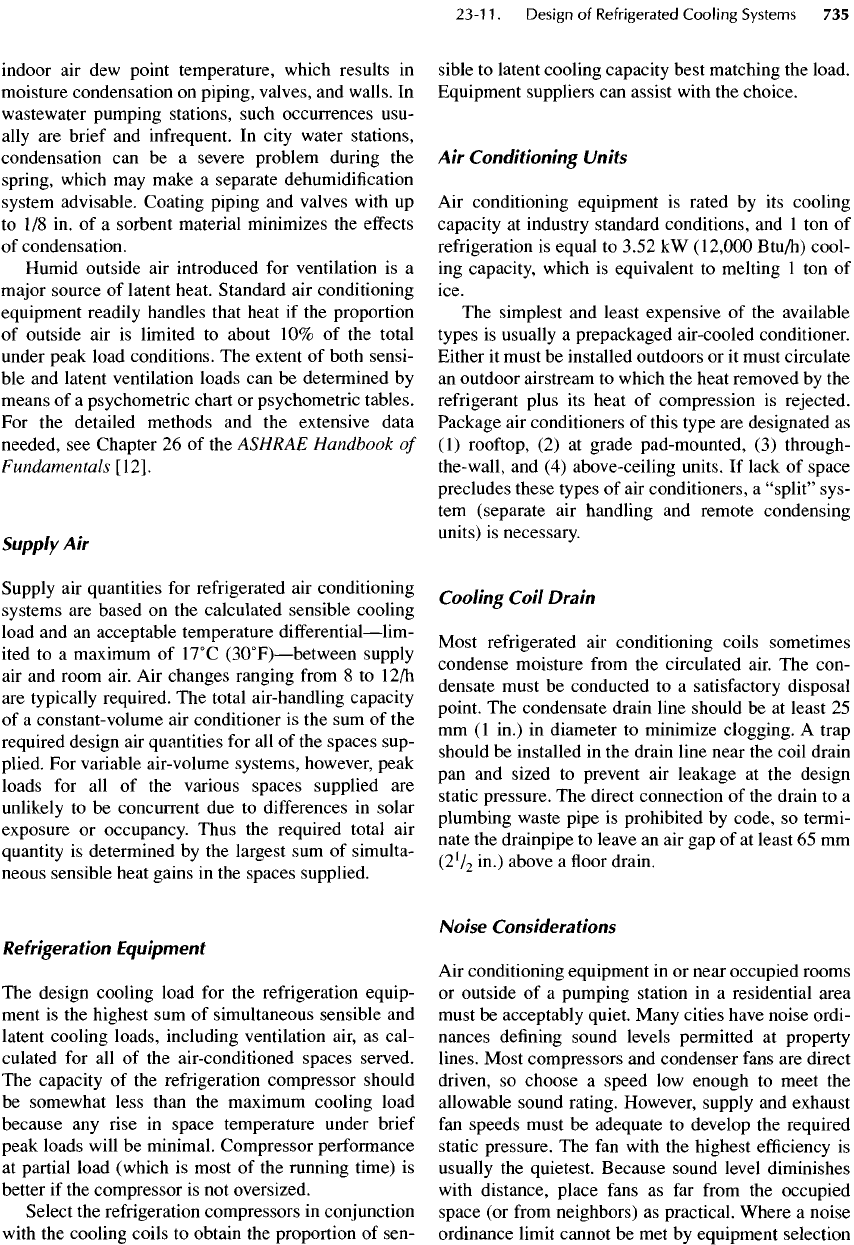
indoor
air dew
point temperature, which results
in
moisture condensation
on
piping, valves,
and
walls.
In
wastewater pumping stations, such occurrences usu-
ally
are
brief
and
infrequent.
In
city water stations,
condensation
can be a
severe problem during
the
spring,
which
may
make
a
separate
dehumidification
system
advisable. Coating piping
and
valves with
up
to
1/8 in. of a
sorbent material minimizes
the
effects
of
condensation.
Humid
outside
air
introduced
for
ventilation
is a
major
source
of
latent heat. Standard
air
conditioning
equipment
readily handles that heat
if the
proportion
of
outside
air is
limited
to
about
10% of the
total
under
peak load conditions.
The
extent
of
both sensi-
ble and
latent ventilation loads
can be
determined
by
means
of a
psychometric chart
or
psychometric tables.
For the
detailed methods
and the
extensive data
needed,
see
Chapter
26 of the
ASHRAE Handbook
of
Fundamentals
[12].
Supply
Air
Supply
air
quantities
for
refrigerated
air
conditioning
systems
are
based
on the
calculated sensible cooling
load
and an
acceptable temperature
differential
—
lim-
ited
to a
maximum
of
17
0
C
(3O
0
F)
—
between
supply
air
and
room air.
Air
changes ranging
from
8 to
12/h
are
typically required.
The
total air-handling capacity
of
a
constant-
volume
air
conditioner
is the sum of the
required
design
air
quantities
for all of the
spaces sup-
plied.
For
variable air-volume systems, however, peak
loads
for all of the
various spaces supplied
are
unlikely
to be
concurrent
due to
differences
in
solar
exposure
or
occupancy. Thus
the
required total
air
quantity
is
determined
by the
largest
sum of
simulta-
neous
sensible heat gains
in the
spaces supplied.
Refrigeration
Equipment
The
design cooling load
for the
refrigeration equip-
ment
is the
highest
sum of
simultaneous
sensible
and
latent
cooling loads, including ventilation air,
as
cal-
culated
for all of the
air-conditioned spaces served.
The
capacity
of the
refrigeration
compressor
should
be
somewhat less than
the
maximum cooling load
because
any
rise
in
space temperature under brief
peak loads will
be
minimal. Compressor performance
at
partial load (which
is
most
of the
running time)
is
better
if the
compressor
is not
oversized.
Select
the
refrigeration compressors
in
conjunction
with
the
cooling coils
to
obtain
the
proportion
of
sen-
sible
to
latent cooling capacity best matching
the
load.
Equipment suppliers
can
assist with
the
choice.
Air
Conditioning
Units
Air
conditioning equipment
is
rated
by its
cooling
capacity
at
industry standard conditions,
and 1 ton of
refrigeration
is
equal
to
3.52
kW
(12,000
Btu/h)
cool-
ing
capacity, which
is
equivalent
to
melting
1 ton of
ice.
The
simplest
and
least expensive
of the
available
types
is
usually
a
prepackaged air-cooled conditioner.
Either
it
must
be
installed outdoors
or it
must circulate
an
outdoor airstream
to
which
the
heat removed
by the
refrigerant
plus
its
heat
of
compression
is
rejected.
Package
air
conditioners
of
this type
are
designated
as
(1)
rooftop,
(2) at
grade pad-mounted,
(3)
through-
the-wall,
and (4)
above-ceiling units.
If
lack
of
space
precludes these types
of air
conditioners,
a
"split"
sys-
tem
(separate
air
handling
and
remote condensing
units)
is
necessary.
Cooling
Coil
Drain
Most refrigerated
air
conditioning coils sometimes
condense moisture
from
the
circulated air.
The
con-
densate
must
be
conducted
to a
satisfactory disposal
point.
The
condensate drain line should
be at
least
25
mm
(1
in.)
in
diameter
to
minimize clogging.
A
trap
should
be
installed
in the
drain line near
the
coil drain
pan and
sized
to
prevent
air
leakage
at the
design
static pressure.
The
direct connection
of the
drain
to a
plumbing waste pipe
is
prohibited
by
code,
so
termi-
nate
the
drainpipe
to
leave
an air gap of at
least
65 mm
(2
V
2
in.) above
a floor
drain.
Noise
Considerations
Air
conditioning equipment
in or
near occupied rooms
or
outside
of a
pumping station
in a
residential area
must
be
acceptably quiet. Many cities have noise ordi-
nances
defining
sound levels permitted
at
property
lines.
Most
compressors
and
condenser
fans
are
direct
driven,
so
choose
a
speed
low
enough
to
meet
the
allowable sound rating. However, supply
and
exhaust
fan
speeds
must
be
adequate
to
develop
the
required
static pressure.
The fan
with
the
highest
efficiency
is
usually
the
quietest. Because sound level diminishes
with
distance,
place
fans
as far
from
the
occupied
space
(or
from
neighbors)
as
practical. Where
a
noise
ordinance limit cannot
be met by
equipment selection
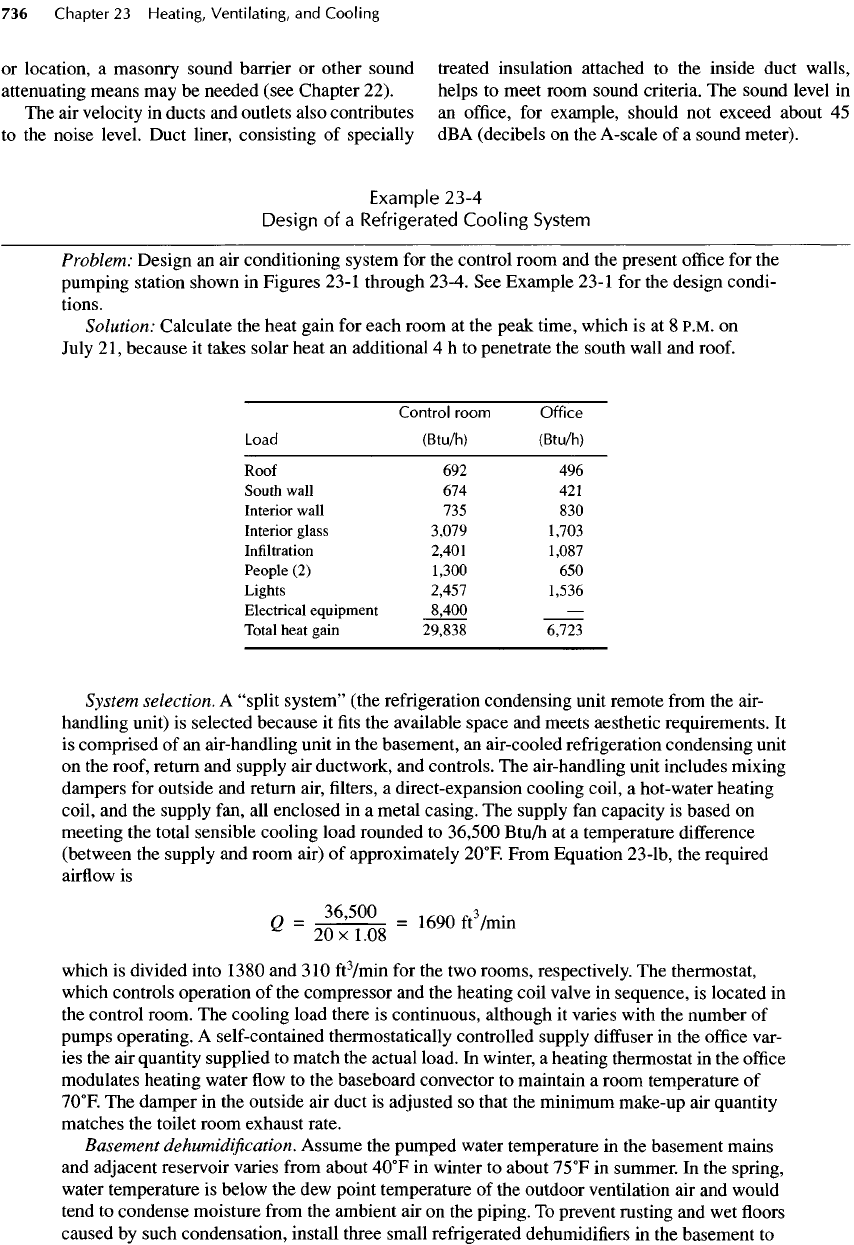
or
location,
a
masonry sound barrier
or
other sound
attenuating
means
may be
needed (see Chapter 22).
The air
velocity
in
ducts
and
outlets also contributes
to
the
noise level. Duct liner, consisting
of
specially
treated insulation attached
to the
inside duct walls,
helps
to
meet room sound criteria.
The
sound level
in
an
office,
for
example, should
not
exceed about
45
dBA
(decibels
on the
A-scale
of a
sound meter).
Example
23-4
Design
of a
Refrigerated
Cooling
System
Problem: Design
an air
conditioning system
for the
control room
and the
present
office
for the
pumping
station shown
in
Figures 23-1 through 23-4.
See
Example 23-1
for the
design condi-
tions.
Solution: Calculate
the
heat gain
for
each
room
at the
peak
time,
which
is at 8
P.M.
on
July
21,
because
it
takes solar heat
an
additional
4 h to
penetrate
the
south wall
and
roof.
Control
room
Office
Load
(Btu/h) (Btu/h)
Roof
692 496
South
wall
674 421
Interior
wall
735 830
Interior
glass
3,079 1,703
Infiltration
2,401 1,087
People
(2)
1,300
650
Lights
2,457 1,536
Electrical
equipment
8,400
—
Total
heat gain 29,838 6,723
System
selection.
A
"split
system" (the refrigeration condensing unit remote
from
the
air-
handling unit)
is
selected because
it fits the
available space
and
meets aesthetic requirements.
It
is
comprised
of an
air-handling unit
in the
basement,
an
air-cooled refrigeration condensing unit
on
the
roof, return
and
supply
air
ductwork,
and
controls.
The
air-handling unit includes mixing
dampers
for
outside
and
return air,
filters, a
direct-expansion cooling
coil,
a
hot-water
heating
coil,
and the
supply fan,
all
enclosed
in a
metal casing.
The
supply
fan
capacity
is
based
on
meeting
the
total sensible cooling load rounded
to
36,500
Btu/h
at a
temperature
difference
(between
the
supply
and
room air)
of
approximately
2O
0
F.
From Equation
23-Ib,
the
required
airflow
is
n
36,500
1
rf
^
r
.
r-3
/
.
Q
=
20TTT08
=
l690
ft
/mm
which
is
divided into
1380
and
3IO
ft
3
/min
for the two
rooms, respectively.
The
thermostat,
which
controls operation
of the
compressor
and the
heating
coil
valve
in
sequence,
is
located
in
the
control room.
The
cooling load there
is
continuous, although
it
varies with
the
number
of
pumps
operating.
A
self-contained thermostatically controlled supply
diffuser
in the
office
var-
ies the air
quantity supplied
to
match
the
actual load.
In
winter,
a
heating thermostat
in the
office
modulates
heating water
flow to the
baseboard convector
to
maintain
a
room temperature
of
7O
0
F.
The
damper
in the
outside
air
duct
is
adjusted
so
that
the
minimum make-up
air
quantity
matches
the
toilet room exhaust rate.
Basement
dehumidification.
Assume
the
pumped water temperature
in the
basement mains
and
adjacent reservoir varies
from
about
4O
0
F
in
winter
to
about
75
0
F
in
summer.
In the
spring,
water
temperature
is
below
the dew
point
temperature
of the
outdoor
ventilation
air and
would
tend
to
condense moisture
from
the
ambient
air on the
piping.
To
prevent rusting
and wet floors
caused
by
such condensation, install three small refrigerated
dehumidifiers
in the
basement
to
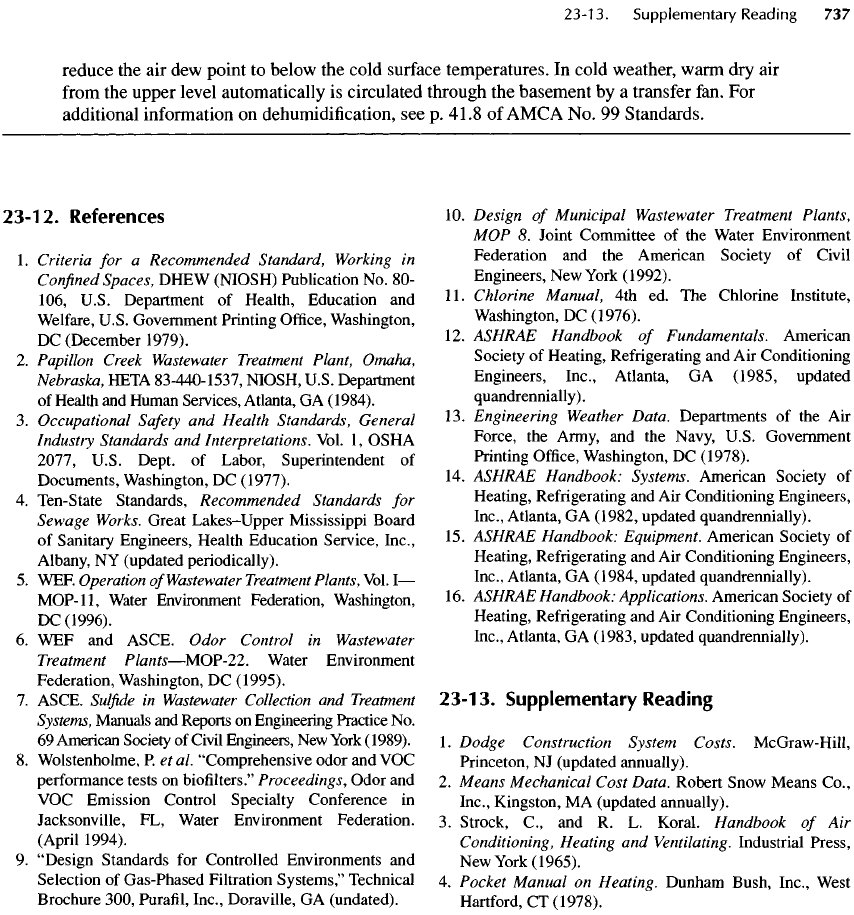
23-12.
References
1.
Criteria
for a
Recommended Standard,
Working
in
Confined
Spaces, DHEW (NIOSH) Publication
No. 80-
106, U.S. Department
of
Health, Education
and
Welfare,
U.S. Government Printing
Office,
Washington,
DC
(December 1979).
2.
Papillon
Creek
Wastewater
Treatment
Plant, Omaha,
Nebraska,
HETA
83-440-1537,
NIOSH, U.S. Department
of
Health
and
Human Services, Atlanta,
GA
(1984).
3.
Occupational
Safety
and
Health Standards, General
Industry
Standards
and
Interpretations. Vol.
1
,
OSHA
2077, U.S. Dept.
of
Labor, Superintendent
of
Documents, Washington,
DC
(1977).
4.
Ten-State Standards, Recommended Standards
for
Sewage
Works.
Great
Lakes-Upper
Mississippi Board
of
Sanitary Engineers, Health Education Service, Inc.,
Albany,
NY
(updated periodically).
5.
WEF.
Operation
of
Wastewater
Treatment
Plants, Vol.
I
—
MOP-Il,
Water Environment Federation, Washington,
DC
(1996).
6. WEF and
ASCE. Odor Control
in
Wastewater
Treatment
Plants
—
MOP-22.
Water Environment
Federation, Washington,
DC
(1995).
7.
ASCE.
Sulfide
in
Wastewater
Collection
and
Treatment
Systems,
Manuals
and
Reports
on
Engineering Practice
No.
69
American Society
of
Civil Engineers,
New
York
(1989).
8.
Wolstenholme,
P. et
al.
"Comprehensive odor
and VOC
performance
tests
on
biofilters."
Proceedings,
Odor
and
VOC
Emission Control Specialty Conference
in
Jacksonville,
FL,
Water Environment
Federation.
(April 1994).
9.
"Design
Standards
for
Controlled Environments
and
Selection
of
Gas-Phased Filtration Systems," Technical
Brochure 300,
Purafil,
Inc., Doraville,
GA
(undated).
10.
Design
of
Municipal Wastewater Treatment Plants,
MOP
8.
Joint Committee
of the
Water Environment
Federation
and the
American Society
of
Civil
Engineers,
New
York (1992).
11.
Chlorine Manual,
4th ed. The
Chlorine Institute,
Washington,
DC
(1976).
12.
ASHRAE Handbook
of
Fundamentals. American
Society
of
Heating, Refrigerating
and Air
Conditioning
Engineers, Inc., Atlanta,
GA
(1985,
updated
quandrennially).
13.
Engineering
Weather
Data. Departments
of the Air
Force,
the
Army,
and the
Navy, U.S. Government
Printing
Office,
Washington,
DC
(1978).
14.
ASHRAE Handbook: Systems. American Society
of
Heating, Refrigerating
and Air
Conditioning Engineers,
Inc., Atlanta,
GA
(1982, updated quandrennially).
15.
ASHRAE Handbook: Equipment. American Society
of
Heating, Refrigerating
and Air
Conditioning Engineers,
Inc., Atlanta,
GA
(1984, updated quandrennially).
16.
ASHRAE
Handbook: Applications. American Society
of
Heating, Refrigerating
and Air
Conditioning Engineers,
Inc., Atlanta,
GA
(1983,
updated quandrennially).
23-13.
Supplementary
Reading
1.
Dodge Construction System Costs. McGraw-Hill,
Princeton,
NJ
(updated annually).
2.
Means Mechanical Cost Data. Robert Snow Means Co.,
Inc., Kingston,
MA
(updated annually).
3.
Strock,
C.,
and R. L.
Koral.
Handbook
of Air
Conditioning, Heating
and
Ventilating. Industrial Press,
New
York (1965).
4.
Pocket Manual
on
Heating. Dunham Bush, Inc., West
Hartford,
CT
(1978).
reduce
the air dew
point
to
below
the
cold surface temperatures.
In
cold weather, warm
dry air
from
the
upper level automatically
is
circulated through
the
basement
by a
transfer fan.
For
additional information
on
dehumidification,
see p.
41.8
of
AMCA
No. 99
Standards.
